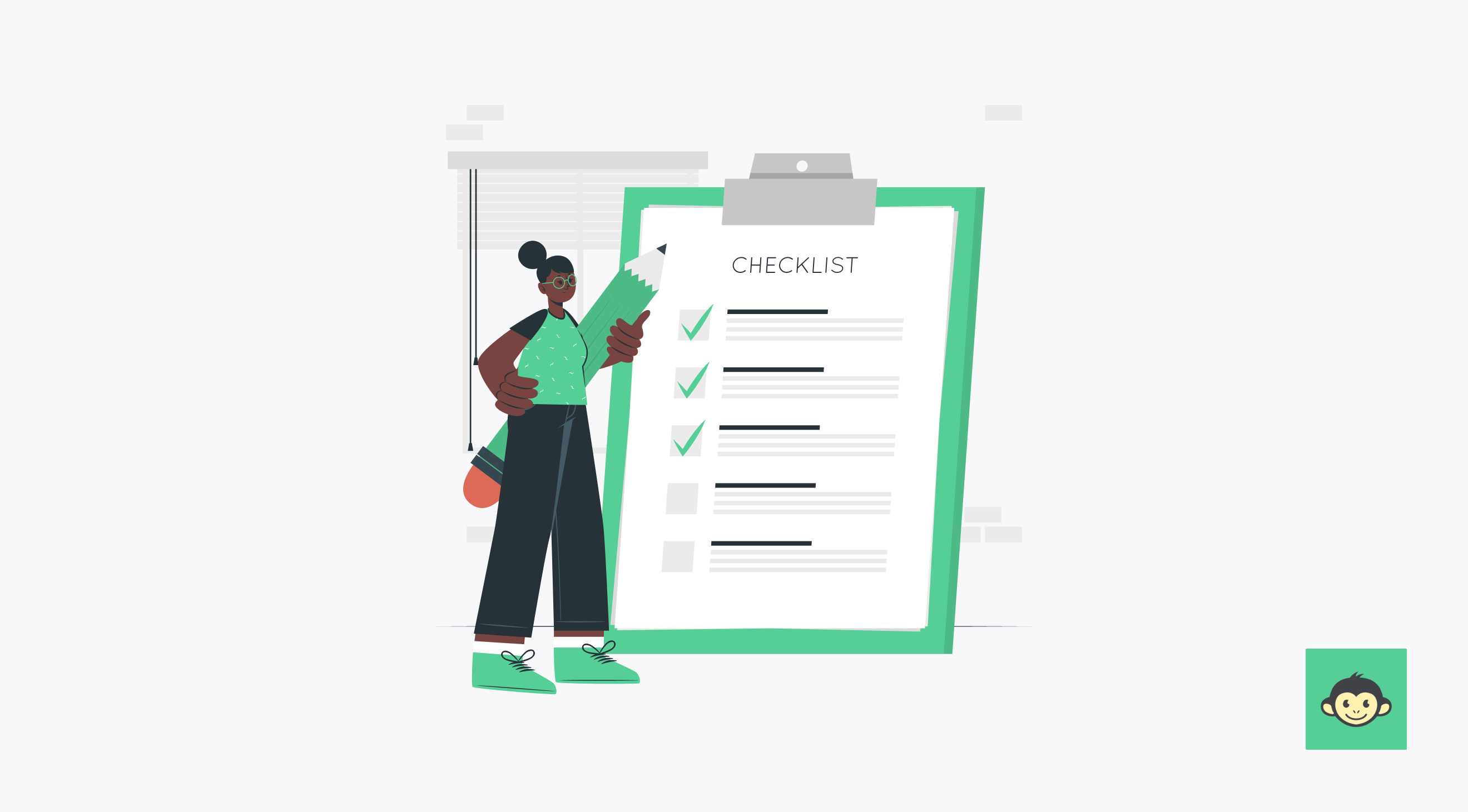Employee engagement checklist: 10 Best steps and purpose to create one in 2024

Have you ever seen a sloth move with the urgency of an impending deadline? Yeah, that's what disengaged employees feel like. But hold on, stressed-out manager! We've got the antidote to cure the "same-old, same-old" syndrome and inject your team with a shot of enthusiasm: The Employee Engagement Checklist!
This isn't some dusty relic from the filing cabinet. We're talking about a cutting-edge, 2024-approved roadmap to a workplace filled with happy, productive employees. Ditch the low morale and get ready to transform your company culture into a haven of passionate go-getters.
In this article, we'll unveil the 10 best steps to craft your own personalized checklist, along with uncovering the secret sauce that makes it all work. Get ready to ditch the deflated energy and become the mastermind architect of an employee engagement superhero story!
What are employee engagement programs?

Employee engagement programs are structured initiatives designed to foster a deep connection between employees and their workplace. These programs aim to enhance job satisfaction, boost morale, and increase productivity by addressing the various factors that influence how invested employees feel in their roles and the organization as a whole.
They typically encompass a range of activities and strategies, from professional development opportunities and recognition and reward systems to wellness and work-life balance initiatives.
By providing employees with avenues for growth, acknowledging their contributions, and supporting their overall well-being, these programs strive to create a more motivated and committed workforce.
One core element of employee engagement programs is effective communication. Regular and transparent communication helps employees feel informed and valued, fostering a sense of trust and belonging.
This might involve regular team meetings, feedback sessions, and open-door policies that encourage dialogue between staff and management. Additionally, engagement programs often include social activities and team-building exercises to strengthen interpersonal relationships and promote a positive workplace culture.
These programs frequently leverage surveys and feedback tools to gauge employee sentiments and identify areas for improvement. By actively listening to employees and responding to their needs and concerns, organizations can tailor their engagement strategies to be more effective.
Ultimately, employee engagement programs are essential for creating a thriving organizational environment where employees feel appreciated, motivated, and aligned with the company’s goals and values.
What is an employee engagement checklist?

An employee engagement checklist is a structured tool used by organizations to ensure that they are implementing and maintaining effective practices to keep employees engaged and motivated.
This checklist typically includes a series of items or actions that managers and HR professionals can review and address regularly to foster a positive work environment and enhance employee satisfaction. It serves as a guide to systematically track and measure the various components that contribute to higher employee engagement.
One key component of an employee engagement checklist is assessing communication practices within the organization.
This includes evaluating the frequency and quality of communication between management and employees, ensuring that feedback mechanisms are in place, and confirming that employees feel heard and valued. Regular check-ins, surveys, and open forums might be items on the checklist to promote effective communication.
Another significant aspect of the checklist focuses on recognition and rewards. It involves verifying that employees are consistently recognized for their hard work and contributions. This might include ensuring the existence of formal recognition programs, peer-to-peer recognition systems, and opportunities for career advancement and development.
The checklist often covers aspects related to employee well-being and work-life balance. This includes reviewing the availability of wellness programs, flexible work arrangements, and support services such as counseling or stress management resources.
By systematically checking these items, organizations can create a supportive and engaging work environment.
What are the objectives of the employee engagement checklist?

The objectives of an employee engagement checklist are centered around systematically enhancing employee satisfaction, motivation, and overall engagement within an organization. Here are the primary objectives to boost employee engagement:
- Identify engagement drivers: The checklist helps in pinpointing the key factors that drive employee engagement. By regularly reviewing these elements, organizations can focus their efforts on the areas that have the most significant impact on employee morale and productivity.
- Ensure consistent communication: One objective is to maintain effective and transparent communication channels between management and employees. The checklist ensures that regular updates, feedback mechanisms, and open forums are in place, fostering a culture of openness and trust.
- Recognize and reward employees: The checklist aims to ensure that recognition and reward systems are consistently applied. It helps in verifying that employees are acknowledged for their contributions, which in turn boosts motivation and loyalty.
- Promote employee well-being: Another key objective is to support employee health and well-being. The checklist includes items related to wellness programs, work-life balance initiatives, and support services, ensuring that employees feel cared for and supported.
- Enhance professional development: The checklist encourages organizations to provide continuous learning and development opportunities. By regularly assessing training programs and career advancement paths, the organization can help employees grow professionally and stay engaged.
- Measure and improve engagement levels: The checklist serves as a tool for measuring current engagement levels through surveys and feedback. This data helps in identifying areas for improvement and implementing necessary changes to enhance engagement.
- Foster a positive work environment: The ultimate objective is to create a positive and inclusive workplace culture. The checklist helps ensure that activities and initiatives promoting team building, diversity, and a positive work atmosphere are consistently implemented.
- Align with organizational goals: Ensuring that employees understand and are aligned with the organization's goals and values is another critical objective. The checklist includes items to verify that employees are aware of the company's mission and how their roles contribute to it.
Why do employee engagement checklists matter in 2024?

Employee engagement checklists matter immensely in 2024 due to the evolving dynamics of the modern workplace. With remote and hybrid work models becoming increasingly prevalent, maintaining a high level of employee engagement is more challenging yet crucial.
These checklists provide a structured approach to ensure that organizations address all aspects of employee well-being and satisfaction, regardless of where employees are located. They help organizations systematically track and implement employee engagement initiatives everywhere, ensuring no critical areas are overlooked.
The competitive job market in 2024 makes employee retention a top priority. Engaged employees are less likely to seek opportunities elsewhere, reducing turnover rates and associated recruitment costs.
A well-maintained checklist ensures that employees feel valued, recognized, and aligned with the company’s goals, fostering loyalty and commitment. This is particularly important as younger generations in the workforce such as Gen Z, prioritize meaningful work and a supportive work environment.
In an era where mental health and work-life balance are at the forefront, engagement checklists ensure that organizations are proactive in promoting wellness and addressing employee concerns.
By regularly assessing and improving engagement practices, companies can create a supportive culture that enhances overall productivity and employee satisfaction. In summary, employee engagement checklists are vital tools for navigating the complexities of the modern workplace, ensuring a motivated, productive, and loyal, and engaged workforce in 2024.
7 Common challenges in implementing an employee engagement checklist at work

Implementing an employee engagement checklist at work can face several common challenges. Here are seven significant ones:
1. Lack of management buy-in
One of the biggest hurdles is gaining support from management. Without strong leadership commitment, engagement initiatives may lack the necessary resources and prioritization, leading to ineffective implementation.
2. Inconsistent application
It can be difficult to ensure that the checklist is consistently applied across all departments and teams. Variability in execution can lead to uneven employee experiences and undermine the overall engagement strategy.
3. Insufficient communication
Effective communication is crucial for improving employee engagement. If the goals and benefits of the checklist are not clearly communicated to employees, they may not see its value or actively participate in engagement initiatives.
4. Resistance to change
Employees and managers may resist new processes and changes, especially if they are accustomed to existing practices. Overcoming this resistance requires careful change management and continuous reinforcement of the benefits of the checklist.
5. Resource constraints
Implementing and maintaining engagement activities requires time, money, and human resources. Organizations with limited resources might struggle to consistently uphold the initiatives outlined in the checklist.
6. Lack of follow-through
Simply having a checklist is not enough; consistent follow-through is essential. If there is no system in place to regularly review progress and make necessary adjustments, the checklist can become a mere formality rather than a practical tool.
7. Measurement difficulties
Measuring the impact of engagement initiatives can be challenging. Without clear metrics and regular assessments, it is hard to gauge the effectiveness of the checklist and identify areas for improvement, making it difficult to demonstrate its value and justify its continuation.
10 Steps to prepare an effective employee engagement checklist

Creating an effective employee engagement checklist involves several thoughtful and strategic steps. Here are ten steps to guide the preparation process to increase employee engagement.
1. Understand your organization’s needs
Begin by assessing the unique needs and culture of your organization. Conduct surveys, focus groups, and one-on-one interviews to gather insights about what drives engagement among your employees.
2. Set clear objectives
Define what you aim to achieve with the engagement checklist. Objectives might include improving communication, increasing job satisfaction, enhancing recognition practices, or promoting work-life balance.
3. Gain leadership support
Secure buy-in from senior management. Their support is crucial for providing the necessary resources and for reinforcing the importance of engagement initiatives across the organization.
4. Develop key engagement areas
Identify the core areas to include in your checklist. Common areas might encompass communication, recognition, professional development, wellness programs, and feedback mechanisms.
5. Create actionable items
For each engagement area, develop specific, actionable items. For example, under communication, an actionable item could be “Conduct monthly team meetings to discuss goals and updates.”
6. Ensure inclusivity
Make sure the checklist addresses the needs of a diverse workforce. Consider different roles, departments, and employee backgrounds to create a universally applicable and inclusive engagement strategy.
7. Set timelines and responsibilities
Assign clear timelines for each item on the checklist and designate responsible parties. This helps ensure accountability and keeps the engagement efforts on track.
8. Implement feedback mechanisms
Establish ways to encourage employees to regularly gather feedback on the effectiveness of the engagement initiatives. This could involve surveys, suggestion boxes, or regular check-in meetings.
9. Review and adjust regularly
Treat the checklist as a dynamic tool. Regularly review its effectiveness and make adjustments based on feedback and changing organizational needs. This ensures that the engagement practices remain relevant and effective.
10. Communicate the checklist
Clearly communicate the checklist and its purpose to all employees. Ensure that everyone understands their role in the engagement process and the benefits it aims to deliver. Regular updates and transparent communication help maintain enthusiasm and participation.
How can an employee engagement checklist help you improve your company culture?

An employee engagement checklist can significantly enhance your company culture by providing a structured approach to fostering a positive and inclusive work environment.
It ensures that key aspects of engagement, and other methods, such as communication, recognition, and professional development, are consistently addressed. This regular attention helps build a culture of transparency, appreciation, and growth.
By setting clear objectives and actionable items, the checklist promotes accountability and follow-through, ensuring that engagement initiatives are not just planned but also implemented effectively. This consistent effort reinforces the company’s commitment to its employees, boosting morale and employee loyalty further.
The checklist facilitates regular feedback mechanisms, allowing employees to voice their opinions and concerns. This active listening fosters a culture of inclusivity and responsiveness, making employees feel valued and heard.
When employees see their feedback leading to tangible changes, it strengthens their emotional connection to the company and its values.
The checklist also emphasizes well-being and work-life balance, crucial components of a supportive company culture. By systematically addressing these areas, the company demonstrates genuine care for its employees' overall health and happiness, leading to a more highly engaged employees and motivated workforce.
Conclusion
An employee engagement checklist is a vital tool for fostering a positive and inclusive company culture. By systematically addressing key areas such as communication, recognition, professional development, and well-being, organizations can create a supportive environment that values and nurtures employees.
This structured approach not only boosts morale and loyalty but also enhances overall employee productivity and job satisfaction. Implementing and maintaining an effective engagement checklist ensures that the company's commitment to its employees remains a top priority, driving long-term success and a thriving workplace culture.
FAQs
1. How often should the employee engagement checklist be reviewed?
The employee engagement checklist should be reviewed quarterly to ensure it remains relevant and effective. Regular reviews allow for timely adjustments based on feedback and changing organizational needs, ensuring continuous improvement in engagement practices and maintaining a positive company culture.
2. Who should be responsible for implementing the checklist?
HR professionals typically lead the implementation of the checklist, but it's crucial to involve managers and team leaders as well. Their active participation ensures that engagement initiatives are consistently applied across all departments, fostering a cohesive and inclusive work environment.
3. What are the benefits of using an employee engagement checklist?
An employee engagement checklist helps streamline engagement efforts, ensuring all key areas are consistently addressed. Benefits include improved communication, increased job satisfaction, flexible work schedules, enhanced recognition practices, and better overall employee well-being, leading to a more motivated and productive workforce.
4. How can an employee engagement checklist improve employee retention?
By systematically addressing factors that contribute to job satisfaction and motivation, an employee engagement checklist helps create a supportive and engaging work environment. This reduces turnover rates as employees feel valued, recognized, and aligned with the company’s goals, leading to higher retention.
5. Can small businesses benefit from an employee engagement checklist?
Yes, small businesses can greatly benefit from an employee engagement checklist. It provides a structured approach to fostering a positive work culture, ensuring all employees feel valued and engaged, which is crucial for productivity, customer satisfaction and growth, regardless of company size.



